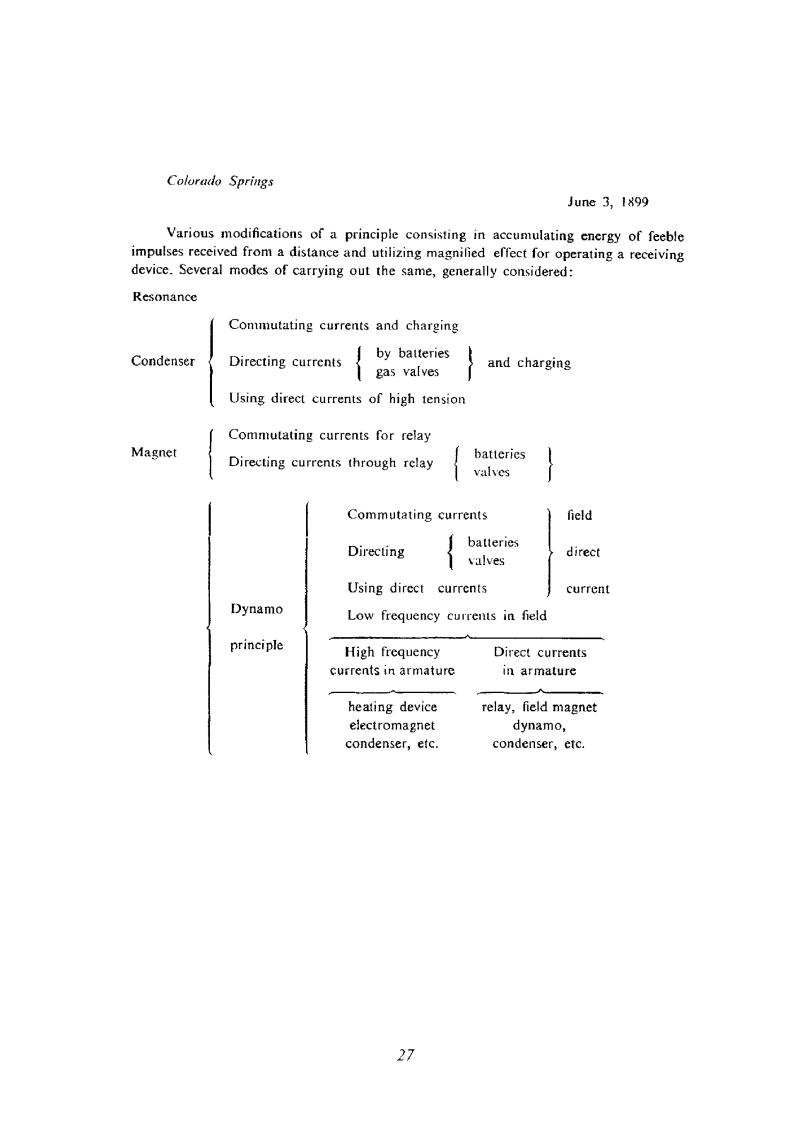
Nikola Tesla Books
Colorado Springs
June 3, 1899
Various modifications of a principle consisting in accumulating energy of feeble impulses received from a distance and utilizing magnified effect for operating a receiving device. Several modes of carrying out the same, generally considered:
Resonance
| Condenser | Commutating currents and charging | ||||
| Directing currents | by batteries gas valves |
and charging | |||
| Using direct current of high tension | |||||
| Magnet | Commutating currents for relay | ||||
| Directing currents through relay | batteries valves |
||||
| Dynamo principle |
Commutating currents | field | |||
| Directing | batteries valves |
direct | |||
| Using direct currents | current | ||||
| Low frequency currents in field | |||||
| High frequency currents in armature |
Direct currents in armature |
||||
| heating device electromagnet condenser, etc. |
relay, field magnet dynamo, condenser, etc. |
||||
27
June 3
During the year 1899 Tesla filed applications for four patents{8, 9, 10, 11) which made use of the principle of âaccumulating energy of feeble impulsesâ. It may be seen from these patents that the function of the capacitor was to store energy from the commutated (in fact rectified) HF current. The condenser is connected to the receiver (a relay) which periodically makes contact(8, 10) when the condenser charges up enough. Both these patents were filed 24th June 1899(9, 10). The other two(9, 11) were filed 1st August 1899. They also refer to a method of accumulating energy but the way the incoming signal controls the charging of the condenser is different: here it causes variations in the resistance of a âsensitive deviceâ which controls the current charging the condenser from a battery. The condenser discharges periodically through the receiver as in the previous case.
Tesla developed the magnet method while he was in Colorado Springs.
June 3
During 1899 Tesla submitted four patents{8, 9, 10, 11) in which he uses the "weak impulses energy accumulation" method. It can be seen from the mentioned patents that the capacitor serves the purpose as the device for accumulation of energy, achieved by commutated (actually rectified) high frequency currents. The receiver (relay) is connected to the capacitor. The receiver is switched on so that the accumulated energy in the capacitor is sufficient for successful receiver operation(8,10). Both patents(8,10) were submitted on June 24, 1899. The other two patents(9,11) were submitted on Aug. 1, 1899. These patents are related as well to energy accumulation method, but another approach is applied to incoming signals for the charging of capacitors. The received signal now varies the resistance of the "sensitive device" and regulates the capacitor charging current from the auxiliary battery. Periodical discharge of charged capacitor through the receiver is the same as in the previous receiver.
The methods with the magnet Tesla developed during his stay in Colorado Springs.

